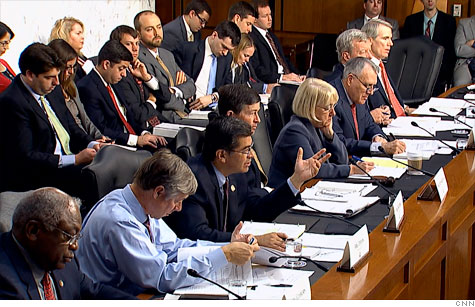
WASHINGTON – Risks are rising that a moribund job market and potentially steep drop in inflation could push the United States into a downward spiral of falling wages and prices.
That nightmare scenario of deflation might seem remote considering a recent rebound in growth, and the U.S. Federal Reserve would almost certainly try to head it off, probably well before prices started to fall.
But some investors and economists say the risk is real.
Inflation is expected to more than halve over the next year as a spike in prices for goods like oil and grains unwinds. Unemployment, meanwhile, will likely hold at nearly double its pre-recession level well into next year, keeping incomes under pressure.
If forecasts are correct, that could present a dangerous combination the Fed might not allow to brew for very long.
“You run the models and that all points to deflation,” said Joshua Dennerlein, an economist at Bank of America Merrill Lynch in New York. “Without some kind of monetary policy help you would definitely get deflation.”
Already, many forecasts for price increases are lower than they were a year ago when the Fed announced it would pump US$600-billion into the banking system to boost growth and counter fears of deflation, which were growing at the time.
The inflation rate, which hit a three-year high of 3.9% in September, could fall to 1.3% by October 2012, according to a measure of expectations calculated by the Federal Reserve Bank of Cleveland.
That would leave the rate below the U.S. central bank’s 1.7% to 2% comfort zone.
FOUNDATION FOR ACTION
With this year’s inflation surge as a backdrop, the Fed is not expected to make any move at its policy meeting on Tuesday and Wednesday.
But looking to mid-2012, when the central bank’s current stimulus program known as “Operation Twist” is due to expire, a high jobless rate and slowing inflation could look worrisome, especially if inflation expectations decline further.
“That would provide more of a foundation for action both to try to reduce the probability of slipping into deflation and to try to provide some more support for economic growth,” said Randall Kroszner, an economist at the University of Chicago who served on the Fed’s board until 2009.
When Mr. Kroszner was a policymaker, deflation fears were perhaps their highest since the Great Depression, the last time U.S. prices and incomes sank in a vicious, self-feeding cycle.
To counter inflation, central banks can always raise interest rates. But the Fed’s normal tool kit for countering falling prices is limited since it has already cut short-term borrowing costs nearly to zero.
The key would be to find a way to ensure a deflationary psychology does not take hold. If consumers and businesses put off purchases because they could be cheaper down the road, that could undercut the economy and push prices down further.
While growth likely accelerated to around a 2.5% annual pace in the third quarter, nearly double the second-quarter rate, several Fed officials have continued to talk about steps they could take to spur a stronger recovery.
Some of the third quarter’s relative strength reflects a one-time bounceback from shocks caused by a spike in oil prices and an earthquake in Japan that disrupted manufacturing.
And dark clouds remain. Economists say a worsening of Europe’s debt crisis could easily send the United States back into recession, further increasing deflation risks.
MONEY PRINTING
Already, nearly one fifth of Americans believe their family incomes will fall during the next six months, the highest level of wage pessimism since October 2009, according to data released on Tuesday by the Conference Board.
At the same time, consumer expectations for long-term inflation, as measured by a Thomson-Reuters/University of Michigan survey, fell this month to the lowest level since the Fed was readying a US$600-billion bond-buying plan a year ago.
Growth in wages has slowed markedly since the recession and they could eventually start falling if the unemployment rate remains high, said Paul Ashworth, and economist at Capital Economics in Toronto. A Reuters poll of economists expects the jobless rate to edge down to just 9% in the second quarter of 2012 from 9.1% now.
Some analysts think the Fed’s extraordinary actions to help the economy — it has already pumped US$2.3-trillion into the banking system — make it nearly impossible for a sustained deflation to take hold.
While much of that money has not seeped into the wider economy because of weak demand and tighter lending standards, eventually it will, greasing the gears of growth and fueling inflation, said Richard Burdekin, an economist at Claremont McKenna College in Claremont, California.
“There is a legitimate concern about deflation,” he said. “But to have a deflation when you have the sort of money growth we’re seeing would be unprecedented.”
Yet investors who believe most ardently that deflation is coming see evidence in the declines in the values of a number of asset classes. U.S. housing prices have fallen about a third since their pre-recession peak, while the Standard & Poor’s stock index is down about a fifth. The Reuters-Jefferies CRB commodities index has also dropped about a third since its 2008 peak, and nearly 15 percent since April of this year.
“When you have deflation in all these other areas, it’s kind of difficult to see how goods and services are going to resist the trend,” said Gary Shilling, who formerly worked on the staff of the San Francisco Fed and as an economist at several Wall Street firms.Financial Post





